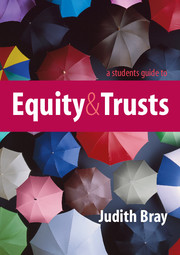Book contents
- Frontmatter
- Contents
- Preface
- 1 Historical introduction
- 2 Equitable remedies
- 3 The classification of trusts and powers
- 4 The three certainties
- 5 Constitution of trusts
- 6 Formalities for the creation of a trust
- 7 Private purpose trusts
- 8 Unincorporated associations
- 9 Resulting trusts
- 10 Constructive trusts
- 11 Trusts of the family home
- 12 Secret trusts and mutual wills
- 13 Charities; the Charities Act and the rules of cy près
- 14 Trustees: appointment, retirement and capacity
- 15 Duties and powers of trustees
- 16 Variation of trusts
- 17 Fiduciary duties and breach of fiduciary duties
- 18 Breach of trust and defences to breach of trust
- 19 Remedies against strangers to a trust
- 20 Tracing
- Index
1 - Historical introduction
- Frontmatter
- Contents
- Preface
- 1 Historical introduction
- 2 Equitable remedies
- 3 The classification of trusts and powers
- 4 The three certainties
- 5 Constitution of trusts
- 6 Formalities for the creation of a trust
- 7 Private purpose trusts
- 8 Unincorporated associations
- 9 Resulting trusts
- 10 Constructive trusts
- 11 Trusts of the family home
- 12 Secret trusts and mutual wills
- 13 Charities; the Charities Act and the rules of cy près
- 14 Trustees: appointment, retirement and capacity
- 15 Duties and powers of trustees
- 16 Variation of trusts
- 17 Fiduciary duties and breach of fiduciary duties
- 18 Breach of trust and defences to breach of trust
- 19 Remedies against strangers to a trust
- 20 Tracing
- Index
Summary
Key points on the historical background to equity and trusts
equity means fairness or justice;
equity was introduced to meet the deficiencies in common law;
common law lacked flexibility in remedies; it failed to recognise rights such as the right of a mortgagor or of a beneficiary under a trust and the writ system was inadequate;
equity provided a ‘gloss on common law’ rather than a complete system of rules and worked alongside common law;
equity was administered initially by the king with assistance from the Chancellor who was a religious person;
the Chancellor later took sole control of equity and the Chancery Court was established;
equity became inflexible and unpopular and consequently there were many conflicts with the common law;
equity and common law were fused under the Judicature Acts 1873–5; and
equity continues to exist as a separate system of law.
The introduction of common law
Until the Norman Conquest, there was no single system of law in England and Wales. The legal system before 1066 mainly consisted of customs that were local to a particular area and were administered and enforced locally or by the King’s Council. After 1066, a system of royal courts was introduced as well as a unified system of rules, which initially existed alongside the local rules. It was a gradual process but eventually a system of law was in place that was ‘common to all’ in England and became common law.
- Type
- Chapter
- Information
- A Student's Guide to Equity and Trusts , pp. 1 - 11Publisher: Cambridge University PressPrint publication year: 2012



